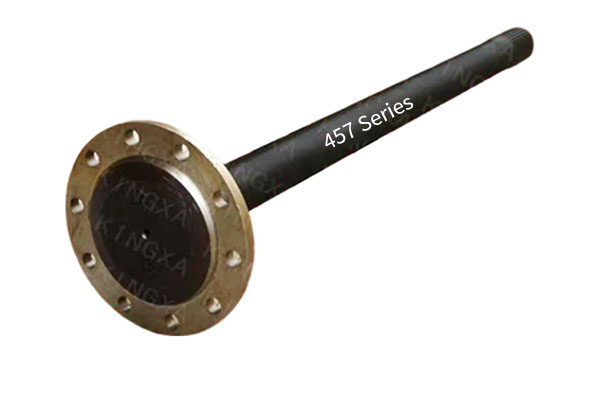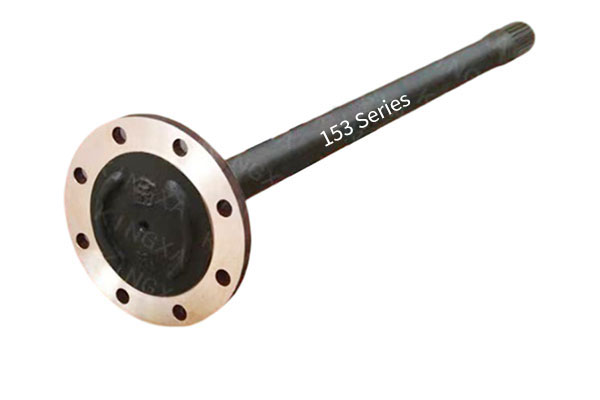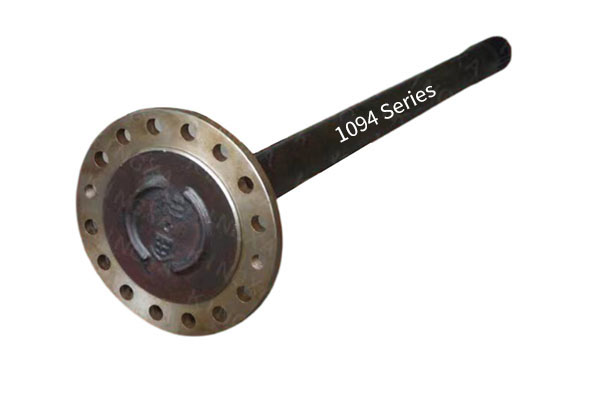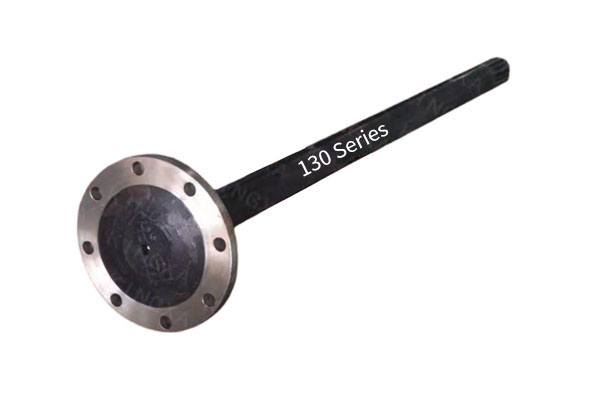Can the high rigidity of a heavy-duty vehicle's rear axle half shaft reduce the risk of deformation during driving?
Release Time : 2025-08-13
In the design and manufacturing of heavy-duty vehicles, the performance of every component is crucial. Especially for components subject to significant loads and dynamic stress, such as the heavy-duty vehicle rear axle half shaft, material selection, design optimization, and manufacturing processes directly impact vehicle safety and reliability. A high-rigidity heavy-duty vehicle rear axle half shaft not only improves overall vehicle performance but also effectively reduces the risk of deformation during driving, ensuring driving safety.
1. The Importance and Challenges of the Heavy-Duty Vehicle Rear Axle Half Shaft
The heavy-duty vehicle rear axle half shaft is a crucial transmission component connecting the differential to the wheels. While transmitting engine torque, it must also withstand various shocks and vibrations from the road. Because heavy-duty vehicles are often used to transport heavy loads or operate in harsh conditions, the heavy-duty vehicle rear axle half shaft requires extremely high strength and rigidity to withstand complex operating conditions. However, traditional axle designs often struggle to fully meet these stringent requirements, especially under prolonged, high-load operation, where bending or torsional deformation may occur, impacting vehicle handling and safety.
2. Selection of High-Rigidity Materials
To improve the rigidity of heavy-duty vehicle rear axle half shafts, the first consideration is the material. High-strength alloy steel is one of the preferred materials due to its excellent mechanical properties. This type of steel not only possesses high yield strength and tensile strength, but also excellent toughness and wear resistance, enabling it to maintain structural integrity under extreme conditions. Furthermore, the addition of appropriate trace elements (such as chromium and molybdenum) can further enhance the steel's hardness and corrosion resistance, extending its service life. In addition to traditional metal materials, composite materials have recently begun to be used in axle manufacturing for certain specialized applications.
3. Optimizing Design and Manufacturing Processes
In addition to selecting the right material, scientific and rational design is also a key factor in improving axle rigidity. Modern computer-aided engineering (CAE) tools can help engineers accurately simulate the operating conditions of axle half shafts under various operating conditions and optimize the design accordingly. For example, by adjusting cross-sectional shape and wall thickness distribution, the stiffness of the rear axle can be significantly improved without significantly increasing weight. Advanced heat treatment technologies and precision machining processes are also essential for manufacturing. For example, induction hardening and carburizing treatments can achieve higher surface hardness, thereby improving wear resistance and fatigue resistance. CNC machine tools ensure machining precision, ensuring that each component's dimensions meet design requirements and avoiding localized stress concentrations caused by manufacturing errors.
4. Benefits of High Rigidity
Reduced Deformation Risk: Highly rigid heavy-duty vehicle rear axle half shafts maintain stability under heavy loads and are less susceptible to bending or torsional deformation, thereby ensuring smooth and accurate power transmission.
Improved Handling Stability: A stable half shaft helps maintain directional control during driving, especially during high-speed cornering or emergency braking, significantly reducing the risk of loss of control.
Extended Service Life: By reducing wear and damage caused by deformation, the durability of high-rigidity half shafts is significantly improved, reducing maintenance frequency and costs.
Improved Ride Comfort: A robust and reliable drivetrain can more effectively absorb and dissipate the impact of road bumps, providing a smoother and more comfortable ride for drivers and passengers.
In summary, the selection of high-rigidity materials, optimized design, and improved manufacturing processes significantly enhance the performance of the heavy-duty vehicle rear axle half shaft, effectively reducing the risk of deformation during driving. This not only improves vehicle safety and reliability, but also provides a better user experience.
1. The Importance and Challenges of the Heavy-Duty Vehicle Rear Axle Half Shaft
The heavy-duty vehicle rear axle half shaft is a crucial transmission component connecting the differential to the wheels. While transmitting engine torque, it must also withstand various shocks and vibrations from the road. Because heavy-duty vehicles are often used to transport heavy loads or operate in harsh conditions, the heavy-duty vehicle rear axle half shaft requires extremely high strength and rigidity to withstand complex operating conditions. However, traditional axle designs often struggle to fully meet these stringent requirements, especially under prolonged, high-load operation, where bending or torsional deformation may occur, impacting vehicle handling and safety.
2. Selection of High-Rigidity Materials
To improve the rigidity of heavy-duty vehicle rear axle half shafts, the first consideration is the material. High-strength alloy steel is one of the preferred materials due to its excellent mechanical properties. This type of steel not only possesses high yield strength and tensile strength, but also excellent toughness and wear resistance, enabling it to maintain structural integrity under extreme conditions. Furthermore, the addition of appropriate trace elements (such as chromium and molybdenum) can further enhance the steel's hardness and corrosion resistance, extending its service life. In addition to traditional metal materials, composite materials have recently begun to be used in axle manufacturing for certain specialized applications.
3. Optimizing Design and Manufacturing Processes
In addition to selecting the right material, scientific and rational design is also a key factor in improving axle rigidity. Modern computer-aided engineering (CAE) tools can help engineers accurately simulate the operating conditions of axle half shafts under various operating conditions and optimize the design accordingly. For example, by adjusting cross-sectional shape and wall thickness distribution, the stiffness of the rear axle can be significantly improved without significantly increasing weight. Advanced heat treatment technologies and precision machining processes are also essential for manufacturing. For example, induction hardening and carburizing treatments can achieve higher surface hardness, thereby improving wear resistance and fatigue resistance. CNC machine tools ensure machining precision, ensuring that each component's dimensions meet design requirements and avoiding localized stress concentrations caused by manufacturing errors.
4. Benefits of High Rigidity
Reduced Deformation Risk: Highly rigid heavy-duty vehicle rear axle half shafts maintain stability under heavy loads and are less susceptible to bending or torsional deformation, thereby ensuring smooth and accurate power transmission.
Improved Handling Stability: A stable half shaft helps maintain directional control during driving, especially during high-speed cornering or emergency braking, significantly reducing the risk of loss of control.
Extended Service Life: By reducing wear and damage caused by deformation, the durability of high-rigidity half shafts is significantly improved, reducing maintenance frequency and costs.
Improved Ride Comfort: A robust and reliable drivetrain can more effectively absorb and dissipate the impact of road bumps, providing a smoother and more comfortable ride for drivers and passengers.
In summary, the selection of high-rigidity materials, optimized design, and improved manufacturing processes significantly enhance the performance of the heavy-duty vehicle rear axle half shaft, effectively reducing the risk of deformation during driving. This not only improves vehicle safety and reliability, but also provides a better user experience.







